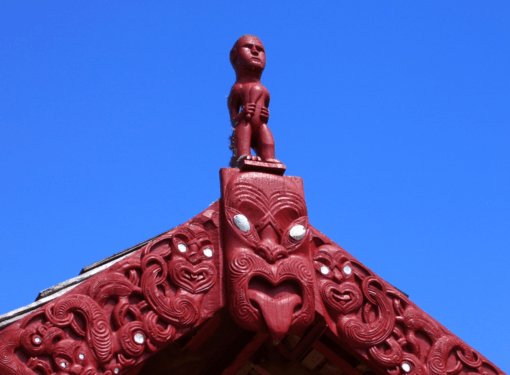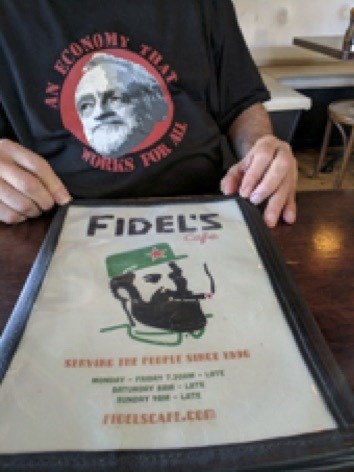
Photo by Sids1 | CC BY 2.0
I am in Aotearoa (to use the Maori name for New Zealand) for the first time.
Decades ago, as a non-sectarian Marxist, I played rugby for two of the British universities I attended. A couple of my team-mates were from Aotearoa, the greatest national team in the history of the sport. My Kiwi teammates weren’t of my political persuasion, though another teammate happened to be a Welsh Trotskyist.
But we’re talking about the 60s, when the most brutal game of the season was the one with the county police team (followed by the one with the county farmers).
No quarter was given when we played the pigs. Several of us had shoulder length hair, which was ripped from our heads by the porcines (we probably provoked them by making oink-oink sounds whenever one of them got the ball). Those of us who went to anti-apartheid and anti-Vietnam War protests were no strangers to such practices on the part of the representatives of law and order.
In return, and because their short hair precluded retaliation in kind, some of us kicked them in the head whenever they were on the ground, saying “We’ll see you again at Grosvenor Square” (the location of the US embassy in London, and the scene of several massive anti-war demos).
The farmers were gentlemen, or approximations thereof, who trash-talked by informing us we should be strung-up from the nearest lamp-post for being reds and hippies, but otherwise confined themselves to delivering the occasional punch when the referee was attending to other matters. They despised us as much as the cops did, but coming from the landed gentry in the main, preferred to focus their violence on the animals they hunted. We trash-talked back by saying it was fantastic they played rugby because foxes had a (brief) reprieve while they were engaged on the rugby field.
Our teams had some players who always retaliated on principle, and a few who saw retaliation of any kind as unseemly, and would not use a fist or boot to exact revenge. The biggest player on one of our teams, Peter __, was known as “Pure Pete” for this reason. Pure Pete however was physically uncompromising in his approach to the game, and being tackled by him was usually an unpleasant experience for the opposition.
Years later Tonga had an international player, Brian Lima, who was nicknamed “the chiropractor” for reasons Pure Pete would have appreciated.
Rugby can be a hard game, but in the end, it is probably one of the fairest of sports — there was no whining to the ref when I played the game, both sides knew when retaliation had to be meted out, and often, deservedly so.
The story is told of Alain Esteve, the formidable “enforcer” in the French national team of the 70s, who was punched thrice by Welsh players in the span of a few minutes, only for the Frenchman to be told by the referee he would be sent off the next time he got punched, since Esteve must have been doing something illegal– albeit unseen by the ref– to have received so many punches in such short order! (This was before the age of TV replays, which of course enable the match officials to get a frame-by-frame reprise of what went on.)
So, the Kiwis rule world rugby, but apart from a gorgeously variegated climate and scenery, and superb wines and food that are extremely affordable (as opposed to the over-priced stuff generally purveyed in London, Paris, or New York), what else are they about, in addition to the colonial, and neocolonial, shadow associated irremediably with the historic injustice done to Aotearoa’s First People, the Mäoris, who also happen to be world-renowned players of the country’s national sport (more about the Mäoris later)?
The cliché is that Aotearoa is a facsimile of 50s Britain. This is simply not the case. Neoliberalism and globalization have made some inroads here, though nowhere near the extent of the world’s great metropolises. This may bolster the mistaken impression that Aotearoa is stuck in some happier past in relation to less fortunate outsiders like us who are immured in societies that have been more fully neoliberalized.
I spent several days in Auckland/Tāmaki Makaurau, Aotearoa’s financial capital, and Wellington, the country’s capital. Obviously neither qualifies as “rural”, so clearly rural Aotearoa will be much different. What was evident is the cosmopolitan nature of these cities.
In each city, I had a friend from Ukania in the 70s and early 80s, who have lived in Aotearoa since the late1980s– one had been a school-teacher colleague, the other was an academic at one of the “plate-glass” universities which cropped up in the 60s and 70s UK. Spending time with my friends dispelled any cartoon-sketch rendition of Aotearoa as a replica of 1950s Britain.
Both Tāmaki Makaurau and Wellington (the former especially) are certainly not facsimilia of 50s Britain. For one thing, they are these days a great deal more multicultural than London was in the 50s and even the supposedly “swinging” 60s.
It is easy to forget that Aotearoa had its own bitter experience with neoliberalism in the 1980s and 90s, with disastrous consequences. Emulating Thatcher’s cruel experiment in the UK, and presaging the current but same-old, same-old, Republican agenda in the US, the country embarked on a policy of market liberalization and so-called free trade, “limited” government, a rigid monetary policy, budgetary restraint in the name of that bogus old chestnut “fiscal responsibility”, and labour-market deregulation.
The New Zealand economy duly tanked– shrinking by 1% between 1985 and 1992, while productivity stagnated at below 1% between 1984 and 1993, and inflation remained at around 9% a year. Foreign debt quadrupled, and the country’s credit rating was downgraded twice. Taxes were cut for top earners (from 66% to 33%), while benefits were reduced by up to 30% for the poorest families. The number of poor grew by around 35% between 1989 and 1992.
Aucklanders of a certain age remember the Great Power Outage, symptomatic of their country’s dalliance with neoliberalism, that lasted for 5 weeks from late February 1998.
New Zealand’s electric industry had been deregulated, and the company running Auckland’s grid, Mercury Energy, had been formed in 1992. Mercury promptly downsized its workforce from 1,411 to 600, and skimped on cable maintenance to boost profits. At the time of the Great Power Outage, Mercury Energy was also busy trying to take over another electric utility, again to enhance revenues.
One of several assessments of the handling of the Outage by Mercury Energy and the city’s administration described their response, somewhat charitably, as “ad hoc”. They predicated their responses throughout the crisis on best-case scenarios, and were flummoxed when none materialized.
Practical preparation for worst-case scenarios costs money— duh! – and thus erodes profit margins.
Auckland’s electricity was/is supplied by 4 poorly maintained mega-cables (there have been five serious outages since the 1998 crisis), which failed in quick succession.
Traffic lights stopped working, ventilation systems broke down in the southern hemisphere summer, people were trapped for hours in elevators, food rotted in supermarkets, hospitals had to cancel operations, emergency services were put under extreme pressure, workers had to hike up 20 floors in high-rise buildings to get to their offices, and giant generators had to be flown in from Australia to tide the city over while the mega-cables were repaired over the course of the 5 weeks.
Harsh jokes were made about Auckland’s Third World electricity grid. One example: what did Aucklanders use before candles and oil lamps? Answer: electricity.
The mayor, whose city was becoming a laughing stock, and whose competence was questioned as the crisis dragged on, lost his bid for reelection soon afterwards, while Mercury’s CEO died of a heart attack at his desk.
Neoliberalism can be death-dealing, even for its beneficiaries and overseers.
According to the World Happiness Index in 2014-2016 for 155 countries, Aotearoa ranked 8th, the US 14th, and the UK19th, while Norway, Denmark, Iceland, Switzerland, Finland, the Netherlands, and Canada were ahead of New Zealand in that order.
Aotearoa does less well in the OECD’s 2017 Gini Inequality Index of 37 industrialized countries. New Zealand ranks 18th, while the UK and US are 21st and 24th respectively. The top 3 least unequal countries are Iceland, Slovakia, Slovenia (in that order), while the bottom 3 most unequal countries are Mexico, Chile, and Turkey (in that order).
This relatively low-ranking for New Zealand when it comes to inequality should be no surprise for the visitor who walks the streets of Auckland. The street sleepers seem to be brown-skinned rather than white (Päkehä in Mäori), a small clue to the existence of a pecking-order when it comes to garnering economic goodies.
The available data confirms that there is such a pecking-order. At the top come whites (Päkehä), then Asians, then Pacific Islanders (Pasifika), and at the bottom are the Mäoris, Aotearoa’s First People.
According to The Guardian, “in the two decades from 1985 onwards, New Zealand had the biggest increase in income gaps of any developed country. Incomes for the richest Kiwis doubled, while those of the poorest stagnated. Middle income earners didn’t do too well, either”.
In a major report produced by the New Zealand Human Rights Commission in 2012, the following was stated:
… the life expectancy rate for Mäori men it is 70.4 years and for non-Mäori men it is 79.0 years. Life expectancy for Mäori women is 75.1 years and for non-Mäori women it is 83.0 years. Pacific peoples have experienced the least improvement in life expectancy over the past 20 years.
The report continues:
… the unemployment rate for those classified as European was 5.6 per cent in the March 2012 quarter. That compares with 13.9 per cent for Mäori; 16.0 per cent for Pacific peoples; 14.1 per cent for MELAA (Middle Eastern/Latin American/African); and 9.4 per cent for Asian…
European people comprise 33 per cent of the prison population, although they make up 68 per cent of the overall population. By contrast, Mäori account for 49 per cent of prisoners, despite being only 15 per cent of the national population…. Pacific peoples comprise 11.31 per cent of all prisoners yet only make up seven per cent of New Zealand’s population.
Another survey indicates that 50% of poor children are Mäori/Pasifika, even though 34% of all New Zealand’s children are Mäori/Pasifika.
A research study has established that “Māori and Pacific ethnic groups typically have poverty rates that are around double those of the European/Päkehä ethnic group, regardless of the measure used”.
Unless significant measures are implemented to deal with the palpable disparities between whites and the Māori and Pacific ethnic groups, inequality in Aotearoa will remain at its current high rate.
The neoliberalism of the 80s and 90s was not really countered in the 2000s. A few palliatives were introduced by the insouciant technocrats who governed Aotearoa in the last decade, but nothing serious has been done to reduce Aotearoa’s burgeoning inequality.
However, the election in October of the Labour Party’s Jacinda Ardern as New Zealand’s third female Prime Minister in a coalition government offers some promise for those hoping for the restoration of a modicum of social democracy.
The 37-year-old Ardern, who calls herself a social democrat, opposes tax cuts for the wealthy and has promised to strengthen the social safety net and labour rights.
For now, New Zealanders will have to wait and see.
And, yes, I was asked the inevitable questions about the Orange Swindler.

The author at Fidel Café, Cuba Street, Wellington. (Photo credit: the author)
Kenneth Surin teaches at Duke University, North Carolina. He lives in Blacksburg, Virginia.